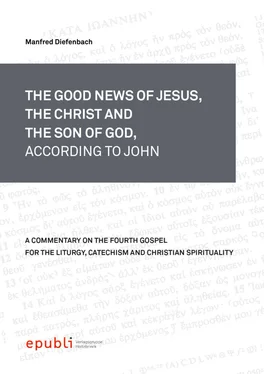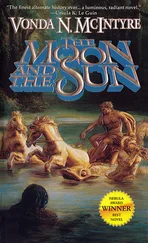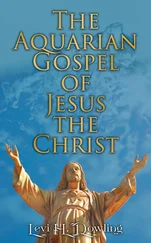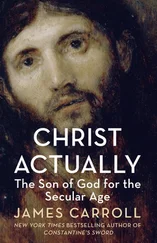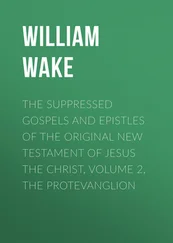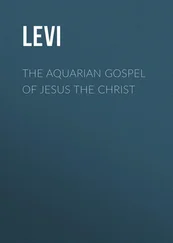MANFRED DIEFENBACH
THE GOOD NEWS OF JESUS,
THE CHRIST AND THE SON OF GOD ,
ACCORDING TO JOHN
A COMMENTARY ON THE FOURTH GOSPEL
FOR THE LITURGY, CATECHISM
AND CHRISTIAN SPIRITUALITY
Epubli GmbH Berlin
© 2015 epubli GmbH, Berlin
Das Werk ist urheberrechtlich geschützt. Die dadurch begründeten Rechte, insbesondere die der Übersetzung, des Nachdrucks, der Entnahme von Abbildungen, der Funksendung, der Wiedergabe auf fotomechanischem oder ähnlichem Wege und der Speicherung in Datenverarbeitungsanlagen bleiben, auch bei nur auszugsweiser Verwertung, vorbehalten.
Die Vergütungsansprüche des § 54 Abs. 2 UrhG, werden durch die Verwertungsgesellschaft Wort wahrgenommen.
This book may not be reproduced, in whole or in part, in any form (beyond that permitted by copyright law) without the publisher’s written permission. This applies particularly to reproductions, translations, microfilms and storage and processing in electronic systems.
ISBN 978-3-7375-5180-9
Foreword
Introduction
- The Three Stages in the Formation of the Inspired Gospels
- From Exegesis to the “Hearts” as the Hermeneutic of the Word of God
0. The Macrostructure/Composition of the Gospel according to John
1. Prologue/Beginning (1:1–18)
2. First Part of John’s Gospel: “Book of Signs” as Jesus’ Public Ministry/Self-Revelation in the World (1:19–12:50)
2.1 Christological Basic Chapter (1:19–51)
2.1.1 “First Day”: The Identity and Authority of John the Baptist – His Mission Declaration to the Jewish Authority of Jerusalem (vv. 19–28)
2.1.2 “Second Day”: John the Baptist at Sight of Jesus (vv. 29–34)
2.1.3 “Third and Fourth/Fifth Day”: The Call of the First Disciples of Jesus (vv. 35–51)
2.2 From Cana to Cana (2:1–4:54)
2.2.1 The Marriage at Cana “on the Third Day” (2:1–12)
2.2.2 Jesus’ Cleansing of the Temple in Jerusalem (vv. 13–22)
2.2.3 Third Comment by the Evangelist (vv. 23–25)
2.2.4 The Theological Discourse between Nicodemus and Jesus (3:1–21)
2.2.5 First Setting as a Journey Note (vv. 22–24)
2.2.6 John the Baptist and the Messiah (vv. 25–36)
2.2.7 First Setting as a Journey Note (4:1–3)
2.2.8 The Discourse between Jesus and the Samaritan Woman (vv. 4–42)
2.2.9 First Setting as a Journey Note (vv. 43–45)
2.2.10 Jesus’ Distant Healing of the Royal Official’s Son from Capernaum in Cana (vv. 46–54)
2.3 Jesus and the Jewish Feasts (5:1–10:42)
2.3.1 His Second Journey (to Jerusalem) (5:1) and the Healing at the Pool (vv. 2–18)
2.3.2 Jesus’ Self-Revelation as Son of God (vv. 19–47)
2.3.3 Jesus’ Multiplication of the Loaves and Fish and the Feeding of 5,000 (6:1–15)
2.3.4 Jesus’ Walking on the Water (vv. 16–21)
2.3.5 Jesus’ Discourse about the “Bread of Life” from Heaven (vv. 22–59)
2.3.6 Variety of Reactions and Division of His Disciples (vv. 60–71)
2.3.7 Jesus’ Self-Revelation in Jerusalem (7:1–52)
2.3.8 The Adulterous Woman and Jesus’ New Chance for Her (7:53–8:11)
2.3.9 Jesus’ Self-Revelation: “ I am the Light of the World ” and the Hearing by the Pharisees (vv. 12–20)
2.3.10 Jesus’ Discussion about the Coming Judgement with “the Jews” (vv. 21–29)
2.3.11 The Dialogue between Jesus and His Believers and His Opponents (vv. 30–59)
2.3.12 Jesus’ Healing of the Man Born Blind on the Sabbath (9:1–41)
2.3.13 Jesus’ Self-Revelation: “ I am the Good Shepherd ” Including the Reactions (10:1–21)
2.3.14 Jesus at the Feast of Dedication in Jerusalem (vv. 22–39)
2.3.15 First Setting as a Journey Note (vv. 40–42)
2.4 Jesus’ Journey to the last Passover in Jerusalem (11:1–12:50)
2.4.1 The Raising of Lazarus (11:1–44)
2.4.2 Summary of the Reaction of the By-standers in Bethany (vv. 45–46)
2.4.3 The Reaction of the Chief Priests and Pharisees as their Council against Jesus (vv. 47–53)
2.4.4 Jesus’ Reaction as Retiring to Ephraim (vv. 54–57)
2.4.5 Jesus’ Anointing by Mary at Bethany (12:1–8)
2.4.6 The Plot against Lazarus (vv. 9–11)
2.4.7 Jesus’ Entrance in Jerusalem (vv. 12–19)
2.4.8 The so-called “Hellen Speech” by Jesus (vv. 20–36)
2.4.9 Jesus’ Fulfilment of Isaiah’s Prediction (vv. 37–43)
2.4.10 The Self-Judgement for the Believers and Not-Believers in Jesus (vv. 44–50)
3. Second Part of John’s Gospel: “Book of Glory” ( 13:1–20:31+ “Appendix” in 21:1–25)
3.1 Jesus’ Self-Revelation for His Disciples (13:1–17:26)
3.1.1 Washing the Feet as the Master’s Example (13:1–20)
3.1.2 Jesus’ Foretelling of His Handing Over (vv. 21–30)
3.1.3 The New Commandment of Love by Jesus (vv. 31–35)
3.1.4 Jesus’ Foretelling of Peter’s Denial (vv. 36–38)
3.1.5 The Farewell Discourses (14:1–16:33)
3.1.6 The Intercessory Prayer (17:1–26)
3.2 The Passion and Death of Jesus (18:1–19:42)
3.2.1 Jesus and His Disciples in the Garden Across the Kidron (18:1–11)
3.2.2 Jesus before the Sanhedrin (vv. 12–14, 19–24) and Peter’s Denial (vv. 15–18, 25–27)
3.2.3 Jesus before Pilate (v. 28–19:16b)
3.2.4 At the Cross of Jesus and His Death (vv. 16c–37)
3.2.5 The Burial of His Body through Joseph of Arimathea and Nicodemus (vv. 38–42)
3.3 Jesus’ Resurrection Appearances in Jerusalem at Easter (20:1–29)
3.3.1 The Risen Jesus and Mary of Magdalene in the Garden of the Tomb (vv. 1–18)
3.3.2 Jesus’ Appearance to His Disciples in Jerusalem (vv. 19–29)
3.4 Epilogue – First Conclusion of the Fourth Gospel (vv. 30–31)
3.5 “Appendix” (21: 1–25)
3.5.1 Jesus’ Appearances to His Disciples by the Sea of Tiberias in Galilee (vv. 1–14)
3.5.2 Simon Peter and “the Beloved Disciple” and their Roles (vv. 15–23)
3.5.3 Epilogue of the Appendix – Second Conclusion of the Fourth Gospel (vv. 24–25)
4. Conclusion
4.1 The Evangelist – Who is “John” respectively the so-called “Beloved Disciple”?
4.2 Time Line – When was the Fourth Canonical Gospel Written?
4.3 The Audience/Receiver of John’s Gospel – Where and for Whom Did the Fourth Evangelist Write his Gospel?
5. Bibliography
5.1 Edition Translation, Concordance, Linguistic Works of Reference, Dictionary
5.2 Short-List of Commentaries
5.3 Biblical Dictionaries
5.4 Introduction
5.5 “Documents” of the Catholic Church and other Churches
5.6 Exegetical Literature
6. Appendix/Graphics
6.1 The Christian Bible
6.2 Three Stages in the Formation of the Gospels
6.3 The Babylonian and Jewish View of the World
6.4 The Structure/Conception of the Gospels – “Who (do you say) I am”?
6.5 Jesus’ Actions in Word and Deed according to John
6.6 Timetable of the Last Days of Jesus in Jerusalem
6.7 Last Days of Jesus of Nazareth in Jerusalem about 30 A.D.
6.7.1 The View of the Four Canonical Gospels
6.7.2 The View of the Fourth Gospel
6.8 Stations of the Cross
6.9 Personal Information about Jesus of Nazareth
6.10 Places of John’s Gospel
6.11 The Apostles’ Creed and some Biblical References
6.12 Liturgical Aspect of Scripture Reading
6.12.1 The Gospel of John during the Liturgical Years of the Roman Catholic Church
6.12.2 The Gospel of John during the Liturgical Years of the Anglican Church
Читать дальше
